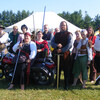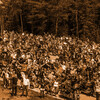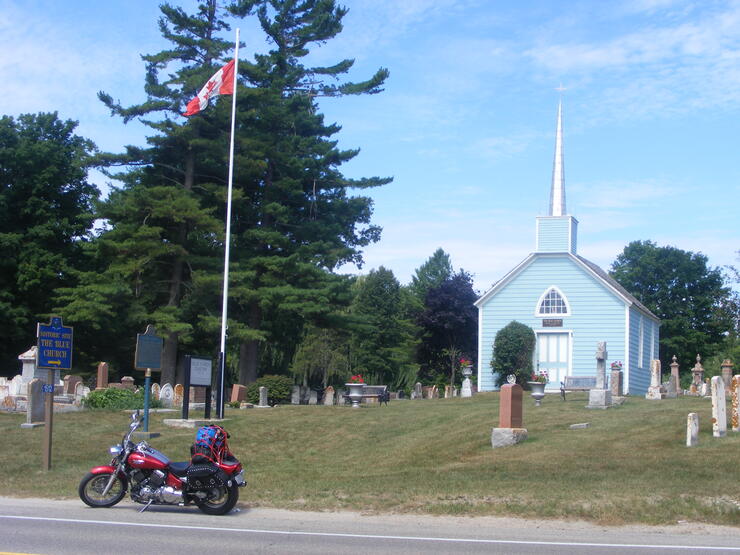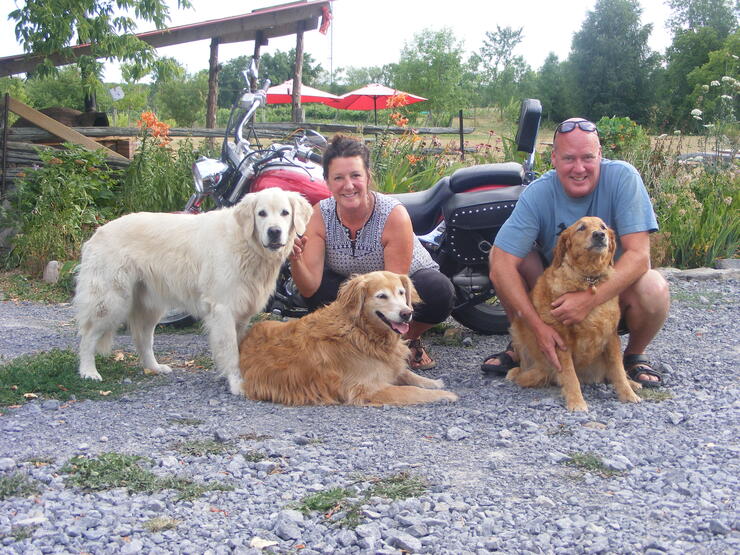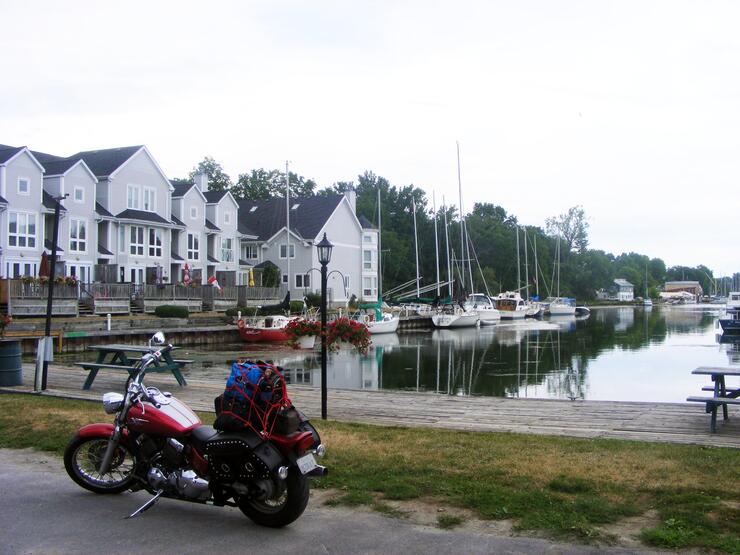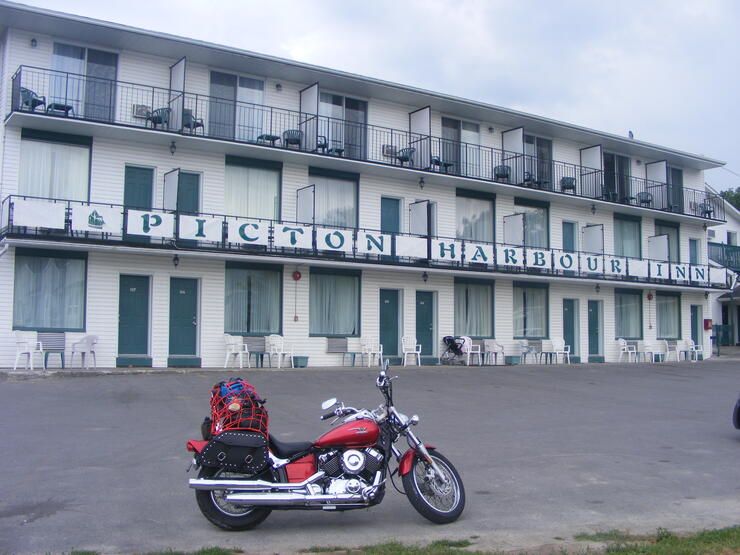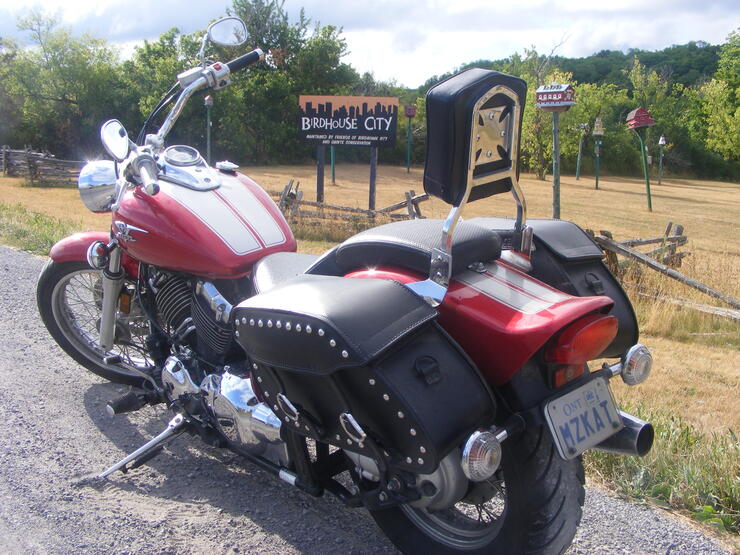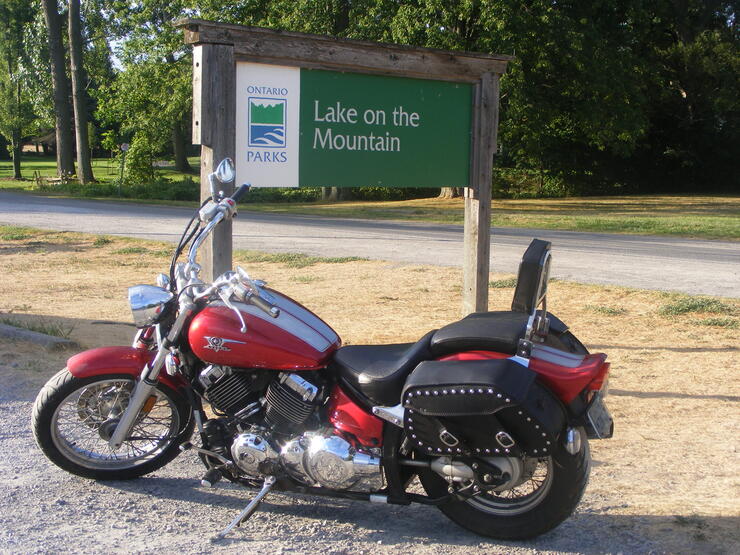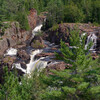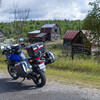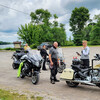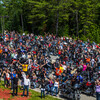
Why the Loyalist Parkway Can't Be Done in One Day
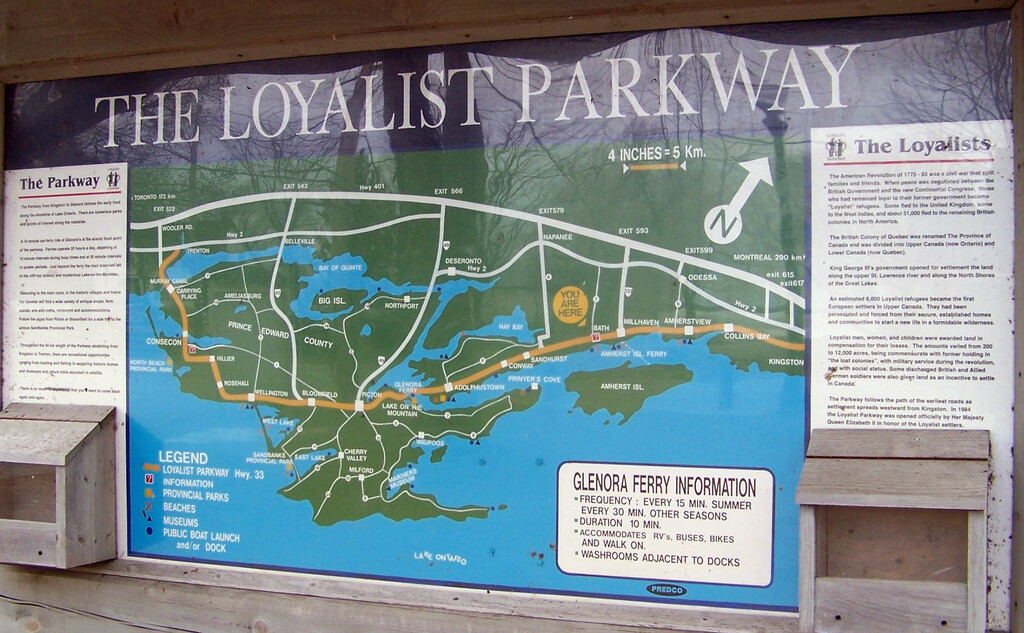
In this third of three pieces about great motorcycle routes in Ontario that also happen to be parkways, we continue our journey by riding the Loyalist Parkway, one of the best ways to explore the shores of the St. Lawrence River and the countryside as you head towards Lake Ontario by motorcycle…
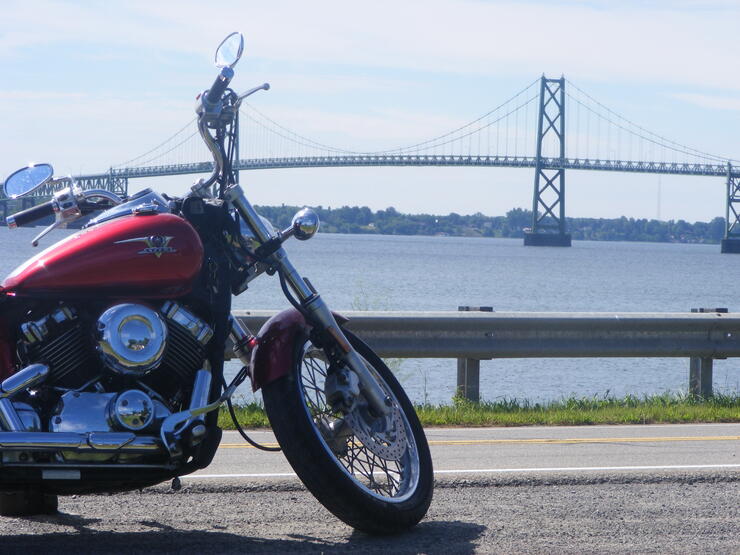
Following my adventures in eastern Ontario and riding the Long Sault Parkway (see The Parkway Chronicles, Episode One), I travelled along the wonderfully scenic and endlessly interesting Highway 2 route from Long Sault towards Kingston.
The Blue Church
Along the way, I encountered some really great points of interest, including an “infamous” landmark in the area: The Blue Church Cemetery.
A Short History: The first Blue Church was built in 1790, and was destroyed by fire. The second church—built in 1809—suffered the same fate. The present church was built in 1845 and remains in very good condition. The cemetery is rich in history, containing the graves of many who were prominent in the early days of Upper Canada, plus a monument to Barbara Heck, the founder of Methodism in America. The care of this church and cemetery belongs to a board, who welcome members and participation in their planning and endeavours. No one knows the real reason why the church was always painted blue, but the tradition is still kept up today.
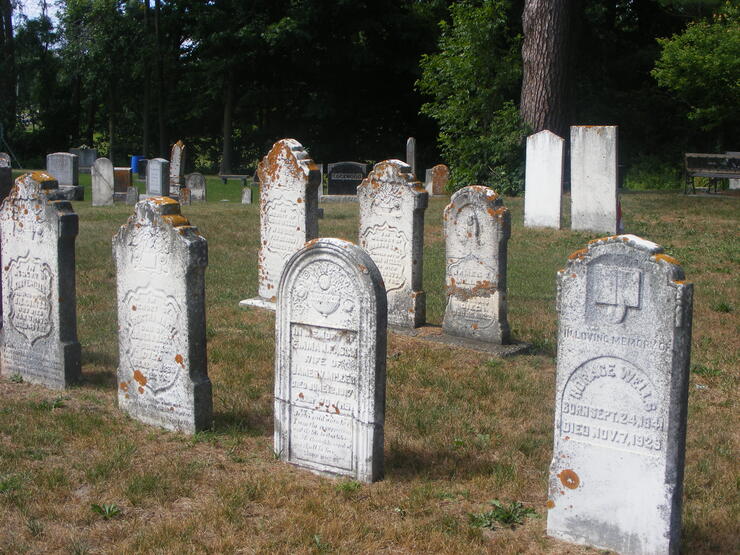
Tyendinaga and Christ Church
At Kingston, I decided to head north to the 401 and (in the interest of efficiency) continued heading west until Ruby and I exited off at Highway 49 and began south again to our destination for the night (Picton).
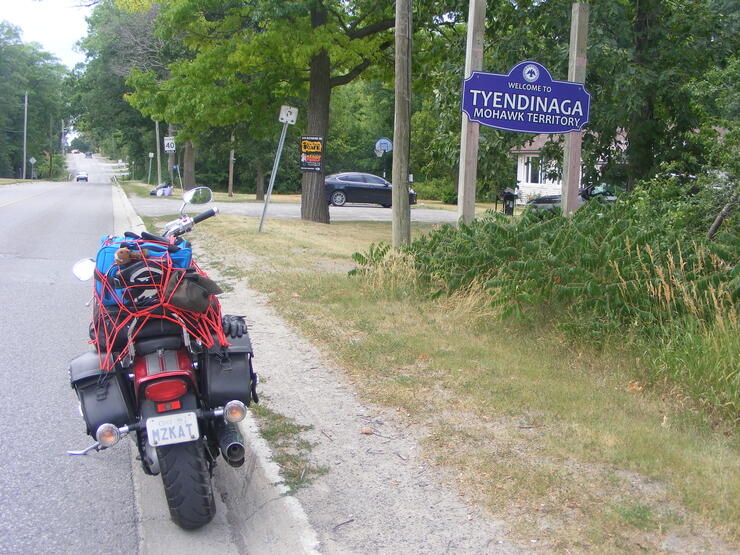
A Short History: Tyendinaga Township is located in the most southeasterly corner of Hastings County and approximately 10 km east of the City of Belleville. It was created in 1820 from land surrendered to the Crown by the Mohawks of the Tyendinaga Reserve. Like the Tyendinaga Mohawk Territory, Tyendinaga Township took its name from Joseph Brant, a noted Chief whose Mohawk name was Thayendinagea.
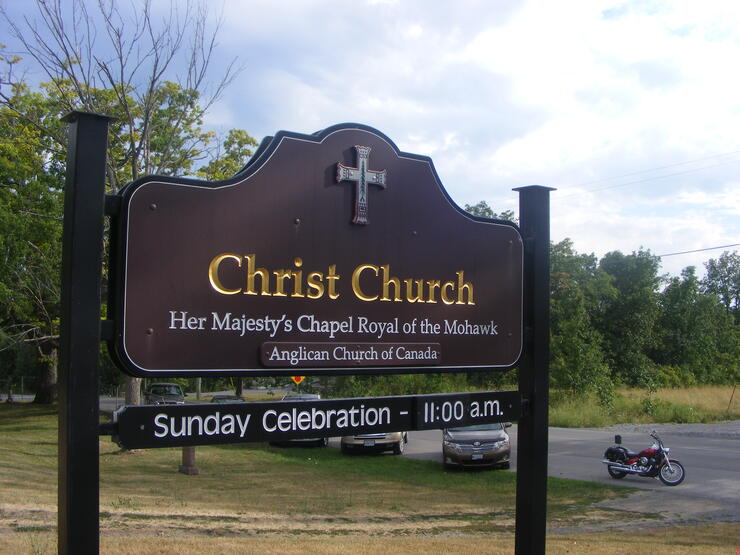
Just off of Highway 49 near Picton, I took a little detour and followed the signs to a magical place on a side road—that’s where I found Christ Church, Her Majesty’s Royal Chapel of the Mohawk.
A Short History: The Mohawks, allies of the British during the American Revolution, settled permanently in Canada following that conflict. A party led by Captain John Deserontyon landed here in 1784 and constructed a chapel shortly thereafter. The church's historic Communion Plate is part of a gift presented to the Mohawks in 1712 by Queen Anne.
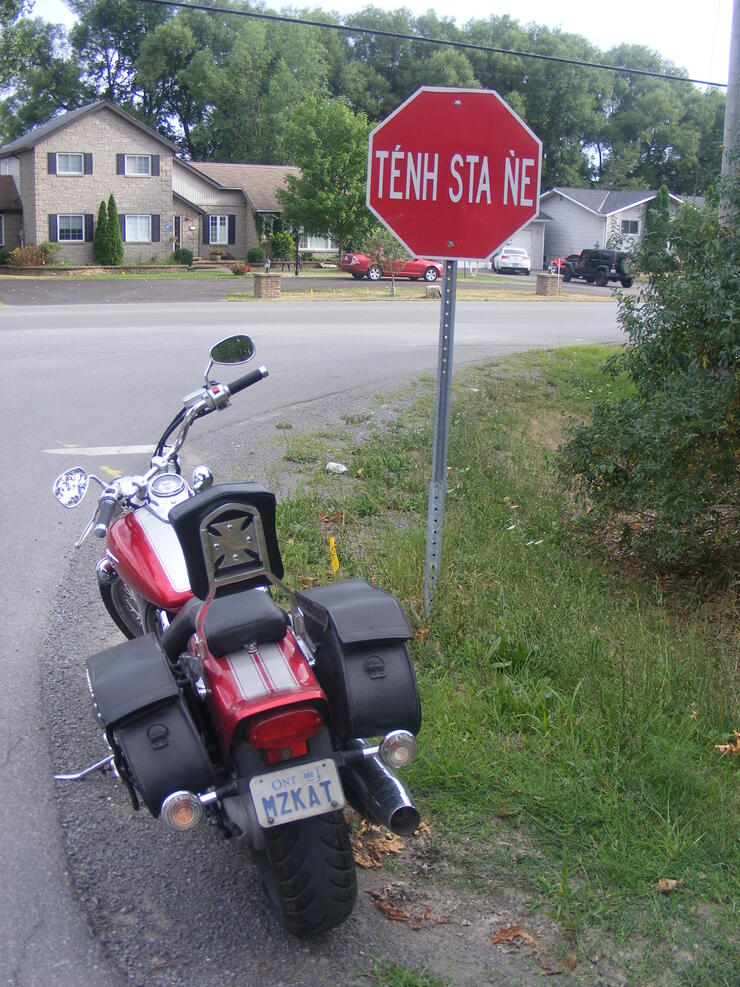
In 1798 King George III gave to the chapel, which became known as a “Chapel Royal”: a triptych, bell, and Royal Coat-of-Arms. The first permanent chaplain, the Reverend Saltern Givens, was appointed in 1831 and, during his incumbency, the present structure was built by the Mohawks in 1843. Although damaged by fire in 1906, Christ Church appears today essentially as originally constructed.
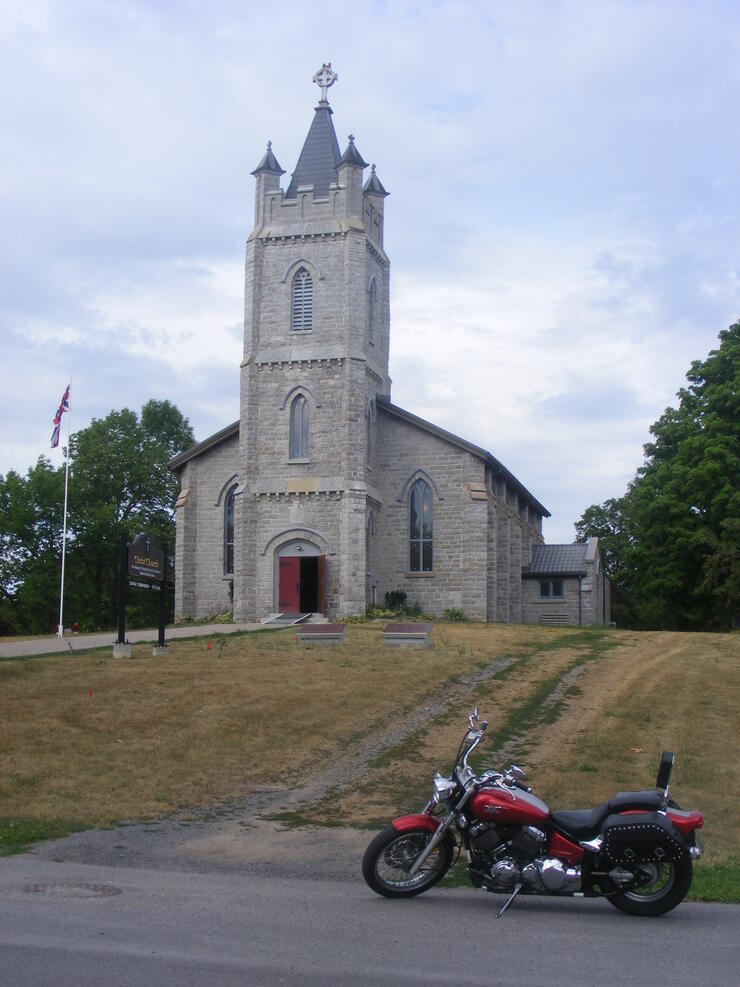
The White Chapel
All along Highway 49, there were signs for tourist stops and historical points of interest, and I took the time—because that’s what you do when you’re on a motorcycle—to do a little exploring and enjoy the ride down to the Town of Picton.
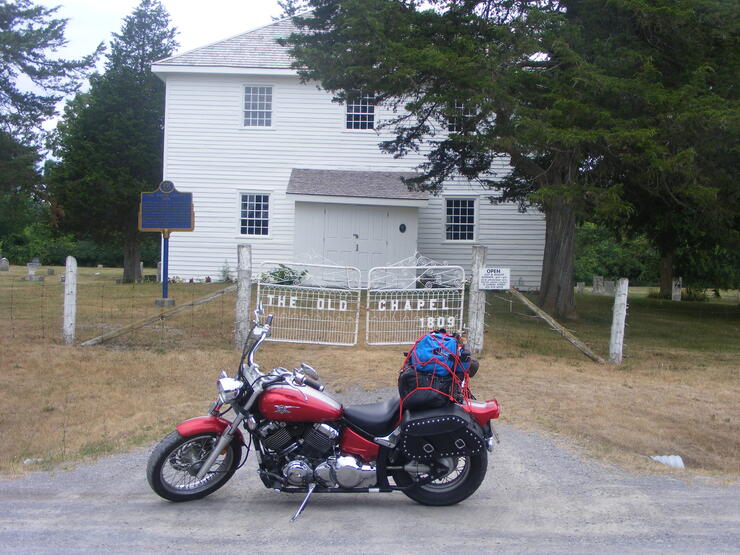
The White Chapel (from the historical plaque): This church, formerly known as the “Old Chapel,” was built on land donated by Stephen Conger, a Loyalist from New Jersey, who had settled with his family in Hallowell Township in 1787. Commenced in 1809, it was the first Methodist church in Prince Edward County and one of the earliest in Upper Canada. Built by William Moore and financed by local subscription, it has been maintained as a place of worship for a longer period than any other church of Methodist origin in Ontario.
The Roblin House
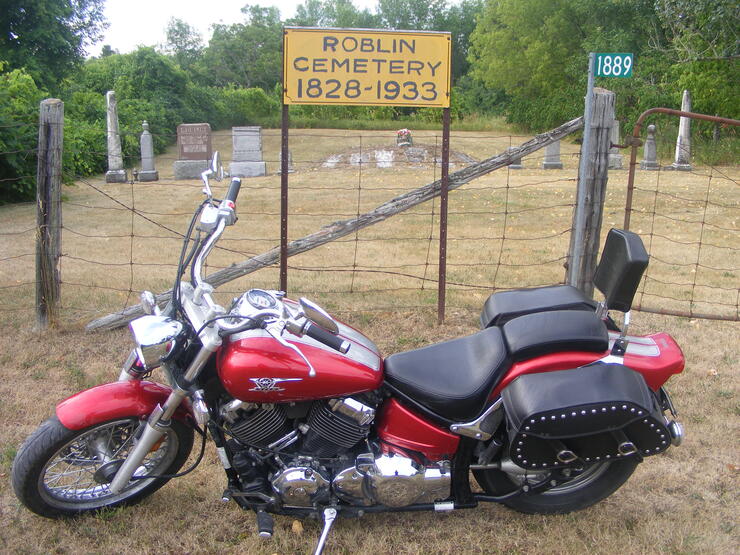
Sir Rodmond P. Roblin House (from the historical plaque): Born and brought up on this property, purchased by his grandfather Levi Roblin in 1821, Rodman Roblin moved to Fort Garry (Winnipeg) in 1877. Elected as an Independent member to the Manitoba legislature in 1888, he was defeated in 1892. Roblin was re-elected in 1896 after joining the Conservatives, and that year became their provincial leader. The Conservatives were victorious in 1899 and Roblin succeeded H.J. Macdonald in October 1900, as premier of Manitoba. His administration, 1900-1915, promoted the western grain trade, encouraged railway construction and by adding large northern territories more than doubled the size of the province. An outstanding leader in Manitoba's formative years, Roblin was knighted in 1912.
Three Dog Winery

The owners of the Three Dog Winery, John and Sacha Squair, live on-site at the winery and want it to become a gathering place for the community, not just a winery where you buy a bottle of wine and leave.
Their goal is to create a place where you not only want to stop and enjoy a glass of wine but also a place where artists, artisanal food producers, farmers, and craftspeople can come and set up their wares and share the “bounty of the County.” They plan to eventually build a stage on the far south-facing slope to offer concerts and small local theatre productions.
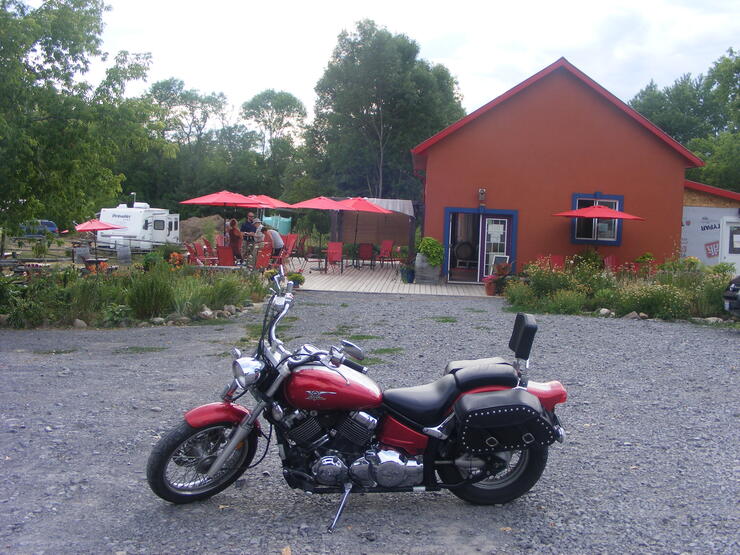
Three Dog Winery gets its name from John and Sacha’s three Golden Retrievers. The original three—Angus, Sienna and Chevy—are all buried at the vineyard as it was always their favourite place to be. The current three—Jersey, Rieki, and Bakkus—are there every chance they can get. All of the dogs are rescues from Golden Rescue Canada. Three Dog will always be dog-friendly (so if you travel with your pooch on board, you won’t have to leave him at home or ship him off to a kennel to go on a wine tour). Three Dog Winery invites you to bring them along, grab a bottle of wine, and take them for a walk down the many trails through the property.
Grab a spot in the shade with “Spot,” have a picnic and relax. John and Sacha believe wine is all about having fun with family and friends, sharing in a good time, and of course enjoying it all with a good glass of wine.
…And then, we arrived in Picton!
In and Around Picton, Ontario
Ruby and I found the perfect place to stay, right in the heart of picturesque Picton. The Picton Harbour Inn has a multi-level Inn on the main road, with a row of motel rooms at the back of the Inn, featuring parking right outside your room and a lovely view of the harbour at the head of Picton Bay. It offers a total of 29 comfortable guest rooms, a two-bedroom apartment, and a three-bedroom apartment, all tastefully decorated and many furnished with locally-made oak furniture, and the walls are hung with vignettes of the past in the form of archival photographs of Picton Harbour in bygone days.
All rooms have cable TV, air-conditioning, telephone and access to WiFi. Most rooms have balconies overlooking one of the most charming small town harbours in Ontario and some have whirlpool baths. As well, all but one room and the two-bedroom apartment have a water-view from the room.
You’ll also find The Lighthouse Restaurant at The Picton Harbour Inn—it offers a quaint atmosphere and delicious home-style cooking for breakfast and lunch.
Got some time to spare? Watch for the signs and head on up to 224 County Road 8 on the eastern outskirts of Picton to Birdhouse City. Home to over 100 birdhouses, with many built as miniature replicas of historical buildings and other recognizable structures, Birdhouse City is a fun point of interest that’s not too far off of the Parkway and well worth a visit.
Lake on the Mountain: The lake is a natural curiosity with a constant flow of clean, fresh water, with no apparent source. Sixty metres above Lake Ontario, there are views towards the Bay of Quinte, the Glenora Ferry (just below) and the north shore. It’s a great picnic spot if you are exploring Prince Edward County, and although there is a day use park, there is no camping at this provincial park.
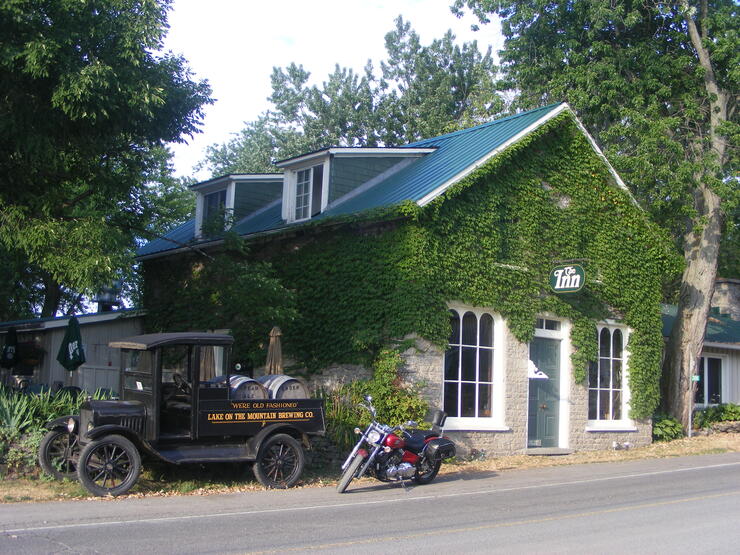
Lake on the Mountain Brewing Company: Located in Glenora (11369 Loyalist Parkway), there is a large manufacturing site, a bottle shop, a beer garden and a taproom. The company is pleased to be able to offer their customers product to take home. Their beers are always available onsite, at their two restaurants as well as a few other select establishments. Continuing the tradition of small batch, quality beer production using well sourced local and international ingredients, the Lake on the Mountain Brewing Company is committed to crafting some of the finest beers in the province.
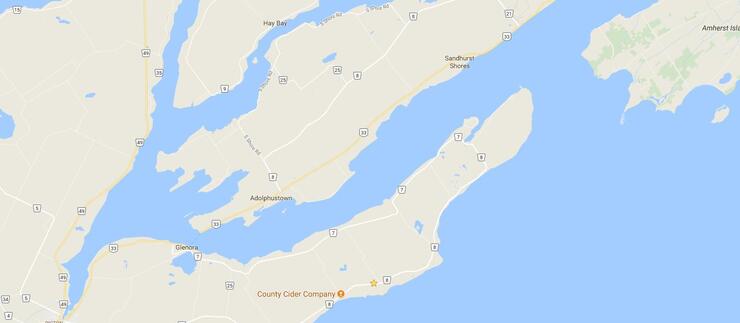
Take the time to travel this amazing route almost all the way out to the tip of the peninsula—you’ll be glad you did! Offering fantastic views, great curves, twists and bends in the road, and a quiet & serene diversion from the Parkway, this route was one of the most pleasant surprises of my entire trip.
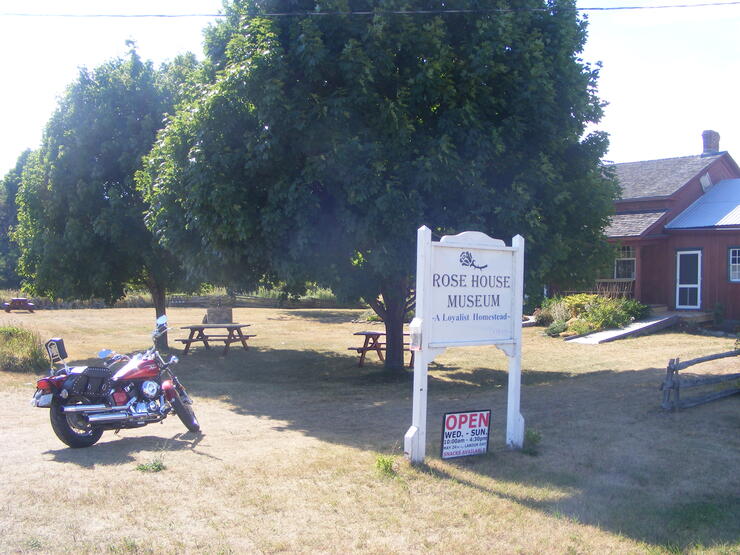
Rose House Museum: Located on County Road 8 near Picton, Rose House Museum is a Loyalist Homestead that has survived since the early 1800s with very few alterations.
Marysburgh Settlement (from the historical plaque located in front of the Rose House Museum): Following the American Revolution, Marysburgh Township was established for the settlement of Loyalists and discharged soldiers of regular regiments. Surveyed in 1784 by the Honourable John Collins, Deputy Surveyor-General, the township was named in honour of Princess Mary, a daughter of King George III. Among its earliest settlers was a small group of disbanded German mercenaries under Baron von Reitzenstein. By October 1784, this party, numbering about 40 persons, had settled in this vicinity and begun to clear and cultivate the land. Shortly after, they erected a log chapel just west of here and were ministered to by Lutheran missionaries. This was one of the earliest German-speaking groups to settle in Ontario.
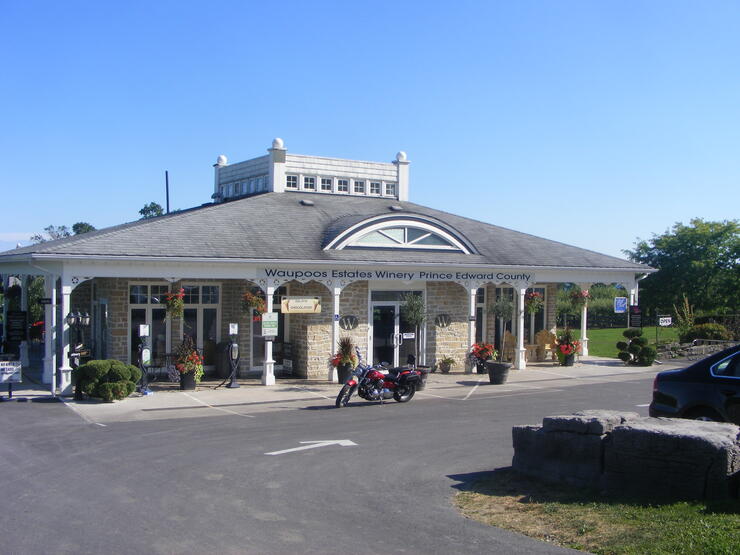
Waupoos Estates Winery: The oldest winery in Prince Edward County, Waupoos Estates Winery sits on a 100-acre waterfront property, right beside Lake Ontario. They have a 20-acre vineyard, an apple and peach orchard, a modest citrus grove, a vast sugar bush (where they tap 1,500 maple trees to produce their own maple syrup), several berry patches, on-site vegetable garden and more. The winery’s restaurant is nestled in the vineyard with views of the property and Lake Ontario, and there is plenty to do and see on the property including a chocolatier and candy store, petting zoo, tours and tastings, cider house and marketplace… and there’s even a beautifully-restored century farmhouse for weary motorcyclists who might want a unique respite from the road.
THE MAIN ATTRACTION: THE LOYALIST PARKWAY
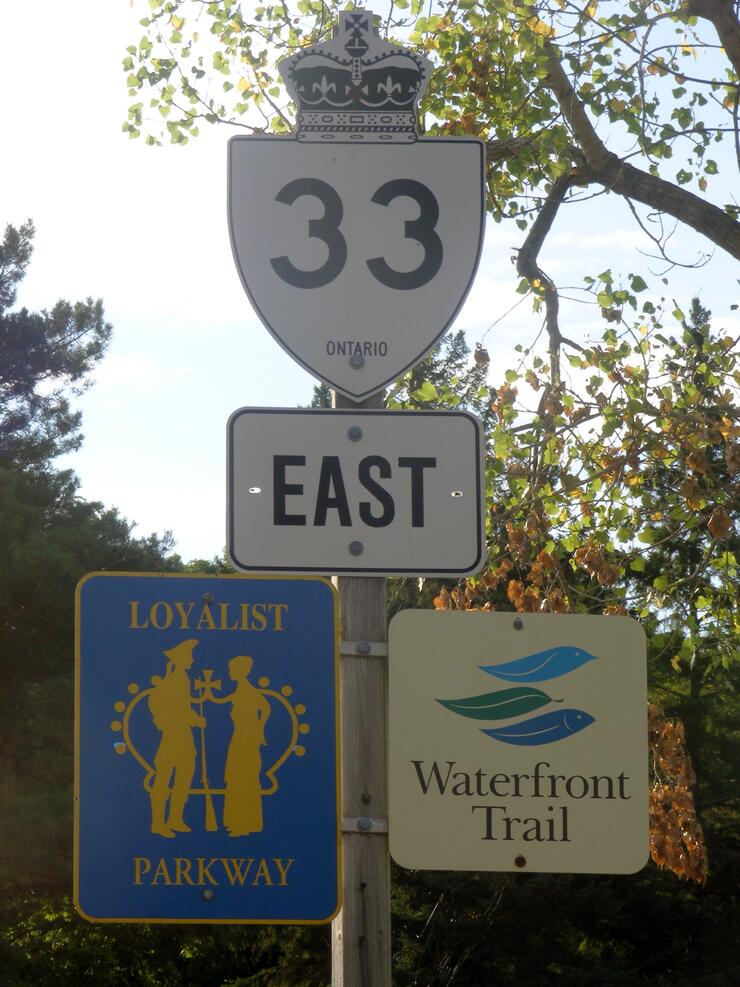
Historical facts & background: Known as “a route through history,” the Loyalist Parkway follows the course of Loyalist settlement which began in 1784 following the American Revolution. There are over 40 listed archaeologic sites and at least 125 heritage buildings on or adjacent to the Parkway.
Queen Elizabeth officially opened the Parkway in 1984 at the eastern entrance near Amherstview.
Highway 33 between Kingston and Trenton—falling mostly within the counties of Lennox and Addington & Prince Edward County—is part of a long-term initiative to preserve and enhance the nationally significant heritage & scenic of the area and the scenic attributes of the route.
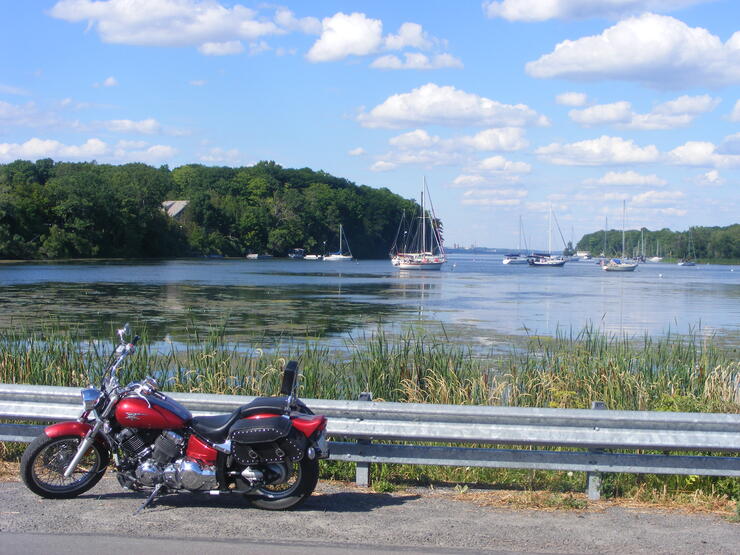
Motorcyclists from around the world have come to love its meandering roads, varied and spectacular scenery, natural beauty, rural roots, and the countless points of interest—including wineries, studios of artisans and craftspeople, historical landmarks and more along the way.
The following links are great for when planning your Loyalist Parkway motorcycle trip:
Kingston Area: Great motorcycle routes in central Ontario
Prince Edward County: www.visitthecounty.ca
South Fredericksburgh: www.sfredheritage.on.ca
Loyalist Township: www.loyalist-township.on.ca
Lennox & Addington County: www.lennox-addington.on.ca/explore/motorcycling
Amherst Island: www.amherstisland.on.ca
ALONG THE LOYALIST PARKWAY…
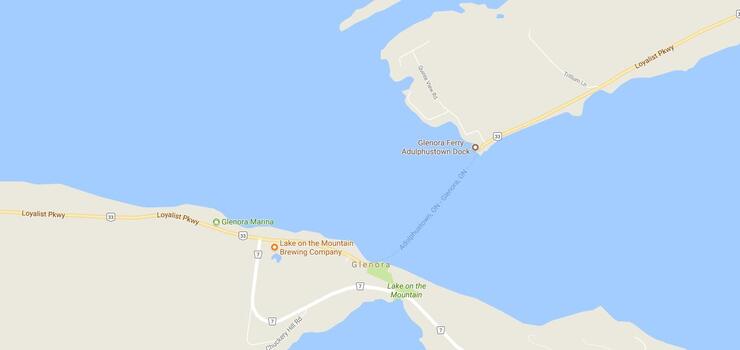
The Glenora Ferry: The Ferry shuttles cars (and motorcycles) and passengers to and from Prince Edward County between Glenora on the west side and Adolphustown on the east side across the Bay of Quinte at no charge. The ferry crossing is operated by the Ontario Ministry of Transportation, which runs at regular 30-minute intervals year-round (and more often at peak times in summer). The crossing (one-way) takes 15 minutes.
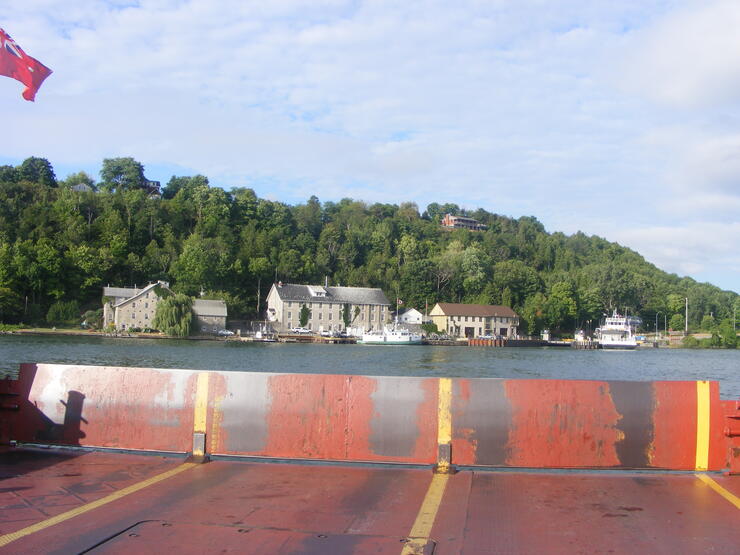
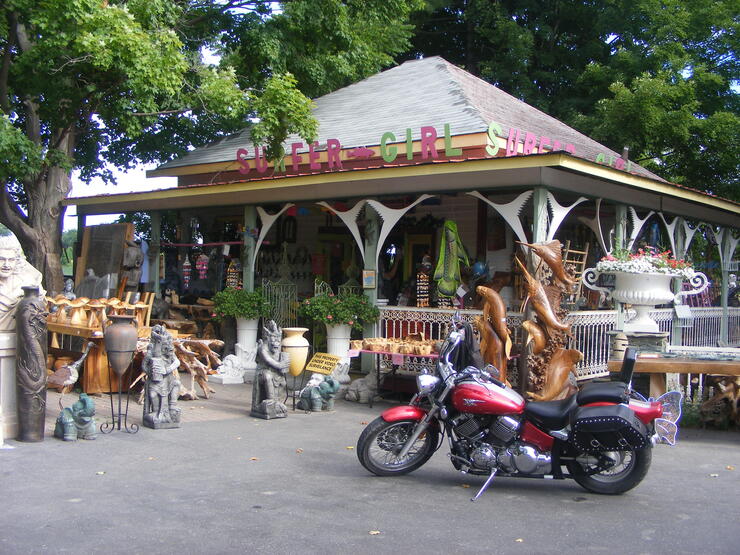
Surfer Girl Shop & Iron World Canada: Located at 13418 Loyalist Parkway just outside of Picton, this is just one of the many interesting stops that pepper the entire length of the Parkway. A landmark in the region, and very biker-friendly, there’s something for everyone at this collection of eclectic items from around the world and right in our own backyard.
As one of the reviews for Trip Advisor Canada says: “This place is OUTSTANDING!!! There are so many beautiful Balinese hand-crafted sculptures of wood and stone including teak vases, root bowls, benches, tables and an assortment of beautiful indoor and outdoor garden features. The jewellery is gorgeous and the prices are very reasonable! The atmosphere is fun and uplifting with so many products to see and multiple shops on an acre. There are just too many unique and one of a kind gems to describe here! I highly recommend checking it out for yourself!!”
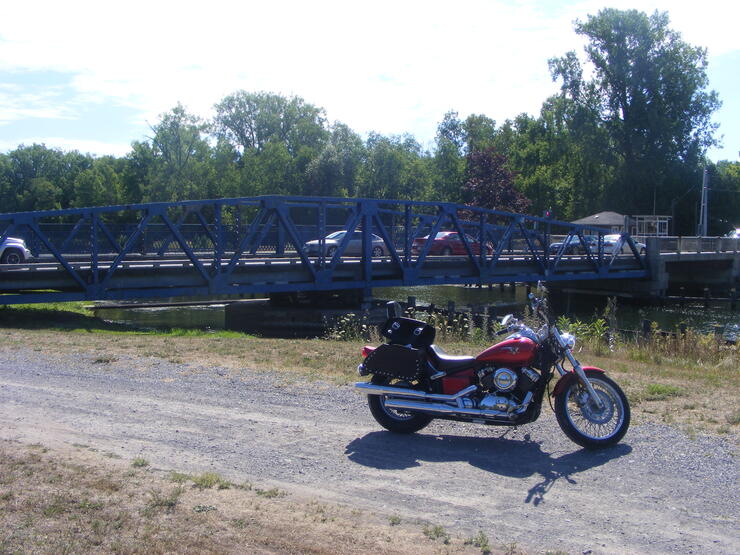
Brighton Road Swing Bridge: The bridge spans the Murray Canal on County Road 64, connecting Prince Edward County and the Municipality of Quinte West. Ruby and I were lucky enough to watch the bridge “swing into action” several times during our travel in that area of the Parkway.
In partnership with Public Services and Procurement Canada, a project to replace the bridge (built in 1947) is underway. The project will replace the Brighton Road Swing Bridge with a new two-lane swing bridge that will also have a pedestrian pathway, a full highway load rating with no restrictions for emergency and service vehicles, and upgraded mechanical and electrical features. The bridge will be fabricated off-site and transported to the site in sections for re-assembly, decreasing the need for closure to vehicular traffic. The concrete road abutment and centre pier will be rehabilitated to accommodate the new bridge. Construction is tentatively scheduled for Fall 2017 and Spring/Summer 2018 during the navigational off-season to reduce impact.
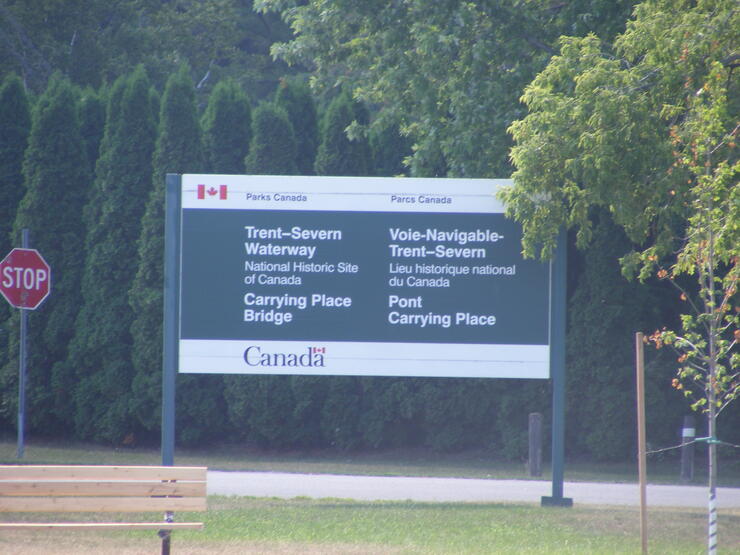
Emm's Restaurant and Country Farm Market: Super biker-friendly, with plenty of room for motorcycle parking. Located at 20261 Loyalist Parkway, Consecon (not far from the Trenton end of the Parkway), this quaint owner-operated restaurant/diner with great home cooking and excellent service and value.
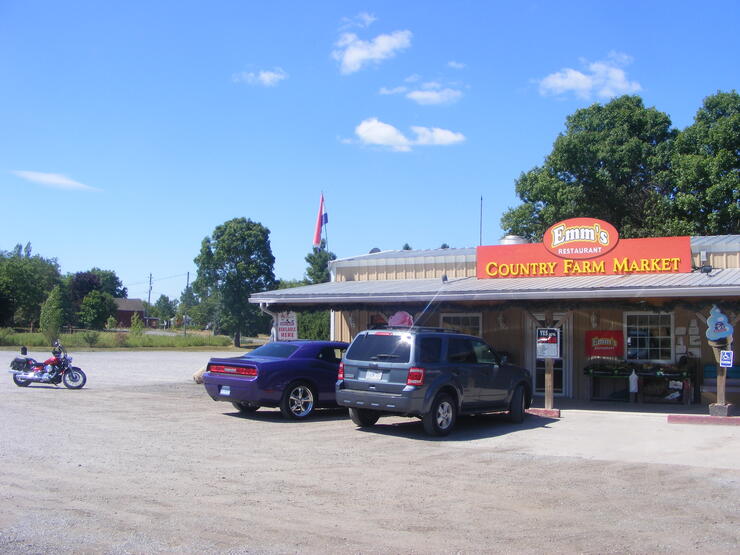
The interior of the restaurant is wonderfully unique and fun, and the restaurant/Farm Market’s claim to fame are the homemade doughnuts made fresh and served warm throughout the day!
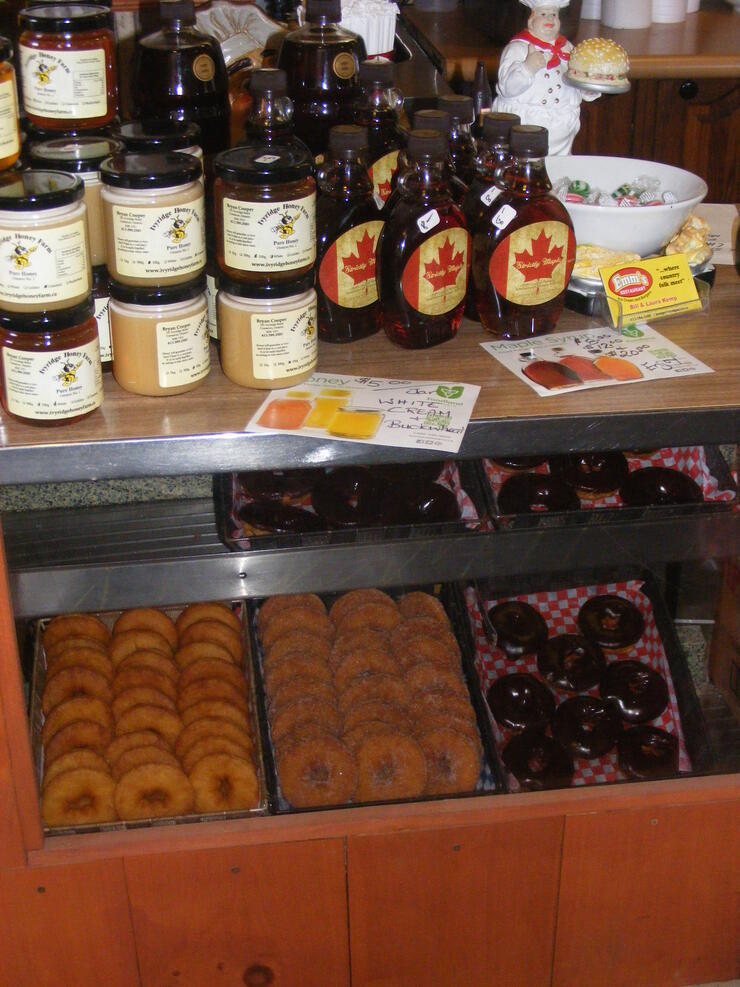
Did you know? Prince Edward County is one of the fastest-growing wine regions in Ontario. Want to know more? Visit www.princeedwardcountywine.ca/wineries/
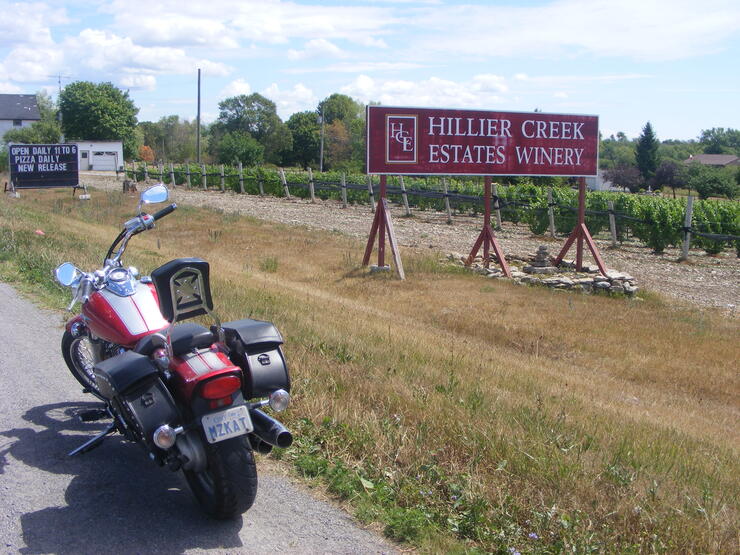
Hillier Creek Estates Winery: One of the many wineries I visited along The Loyalist Parkway, Hillier Creek Estates’ vineyards cover 30 acres and grow Pinot Noir, Gamay, Riesling, Chardonnay, and Vidal grapes. The centrepiece of their property is a beautifully restored 160-year-old barn transformed into a winery, tasting room, and retail store, and is an eye-catching piece of county history directly visible from Loyalist Parkway (Highway 33).
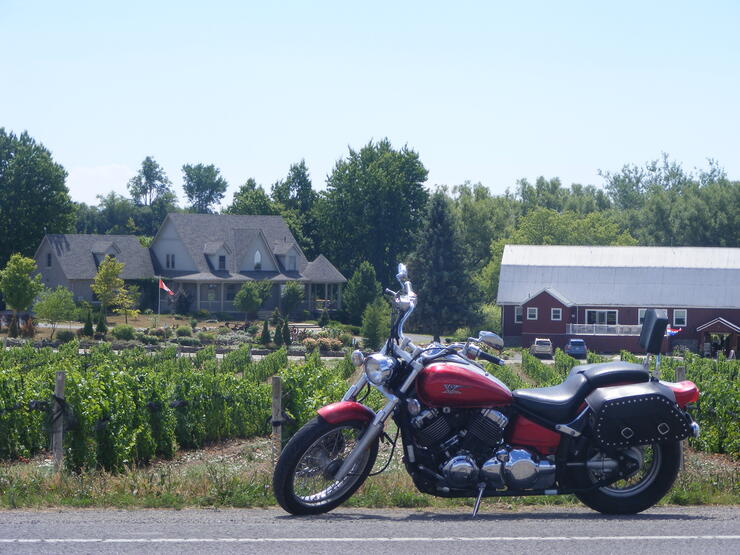
From one end to the other, The Loyalist Parkway is full of the best of everything that makes for a great motorcycle route and time spent in the wind and on the open road. Whether passing through quaint little towns, along the water’s edge, visiting a winery, brewery or artisan’s shoppe, or pulling over to the side of the road to take in a view, The Loyalist Parkway should definitely be on your “Bike It List.”
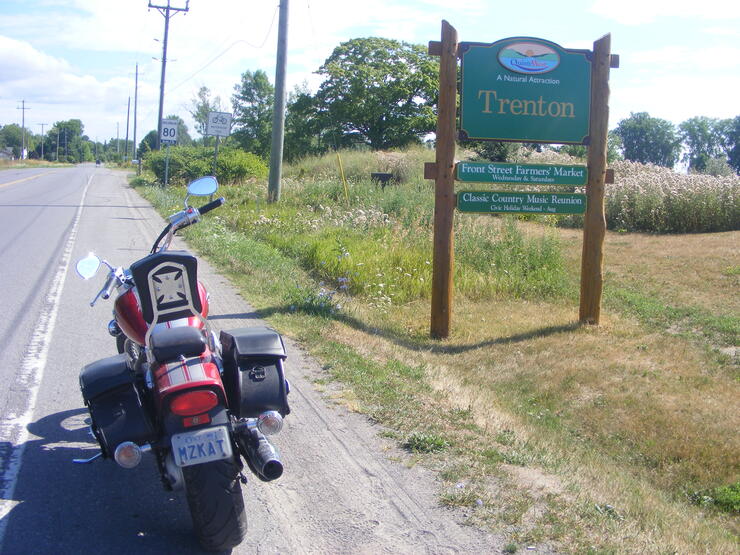
PLAQUES ALONG THE LOYALIST PARKWAY
Below, you’ll find a summary of the information found on plaques for some of the over 40 listed archaeologic sites and the at least 125 heritage buildings on or adjacent to the Parkway.
Check them out and be sure to add some of them to your ‘To Look For’ list while exploring…
(note of thanks to Wayne Cook and Alan Brown for the resource material):
Bay of Quinte Carrying Place (at County Rd. 64)
A cairn marks the site of a meeting in 1787 between Sir John Johnson and Mississauga Chiefs. The British were seeking land for alternate routes from Lake Ontario to Lake Huron.
The Kente (Quinte) Mission (at the park in Consecon)
In 1668, two Sulpician priests from France established a mission near here to serve the Iroquois on the north shore of Lake Ontario.
Daniel Reynold's House (Wellington Main Street)
Built by Daniel Reynolds, possibly as early as 1790, this may be the oldest house in the County.
West Lake Boarding School (East end of Bloomfield)
This fine example of Loyalist Neo-Classic Architecture was opened as a boarding school in 1841. Thomas Clarke, a Quaker, was the first superintendent. It is now a private residence.
Sir John A. Macdonald in Hallowell (at Post Office, Picton)
John A. Macdonald, Canada's first Prime Minister practiced law here in 1833, gaining his first experience in public administration. In 1835 he set up his law practice in Kingston.
Founding of Hallowell (Hill St. and Bay Street east of the Fairgrounds)
An accounting of the growth of the settlement of Hallowell on the harbour and its later absorption with Macaulay's Picton
Prince Edward County Fair Grounds (north Main St., Picton)
Since 1836 this fairground has contributed to the business and social life of the County. The Grandstand, Crystal Palace, Fruit Building are functional and are still used.
Paxton's Crystal Palace
London, England's Crystal Palace inspired many homemade replicas in Ontario. This, the sole survivor, was built in 1890. Restoration was started in 1990 and, with the help of the Government of Ontario, the Government of Canada , the County of Prince Edward and public contributions, completed in 1996.
The County Buildings
The Registry Office (1871) is a well-preserved example of a typical post-Confederation building. It was used up until 1975. Shire Hall Council Chamber (1874) is where the Town Council met; it now serves the Prince Edward County Council. Both can be found on Main Street north of Loyalist Parkway.
County Court House (Union Street, Picton)
This fine Greek Revival building was built in 1832 on a plot donated by Rev. William Macaulay. John A. Macdonald practiced in this courtroom . The building is still used and houses the County Archives and Registry Office.
Macaulay Heritage Park (Union and Church Street, Picton)
The Heritage Park complex contains Rev. Macaulay's house (1830) and furnished in a style consistent with the last half of the 1800's. The Church of St. Mary Magdelene, built about 1825, is now a museum.
Rev. William Macaulay 1794- 1874 (at Union and Church Streets, Picton)
Macaulay was the son of a Loyalist and received a grant for 400 acres. He studied under the Rev. John Strachan , later attended Oxford University and was ordained in 1818. He used his own funds to construct St. Mary Magdelene Church and also donated land for the nearby Court House.
The Conference Church (Chapel and Main streets)
In 1824 the first Methodist "Canada Conference" which resulted in the separation of the U.S. and Canadian churches took place here in a frame church which stood on this site. The present Church was erected in 1898.
The Mills Of Glenora (at Lake On The Mountain Provincial Parkette)
Tells of the settlement of Glenora and Major Peter Van Alstine's mills. At the water's edge below, a wide variety of industrial buildings have come and gone seeking the power of the water flumed from above. John A. Macdonald's father lived here and ran a mill. Later the Little Giant Water Wheels were made here in James Wilson's machine shop which now houses a Government of Ontario Fisheries hatchery and office.
The Royal Union Flag (west dock at Glenora ferry)
This British Royal Standard was the flag honoured by the Loyalist settlers when they came to the area. It was created in 1606 and endured until 1801.
Bay of Quinte Loyalist Settlement (east dock at Glenora Ferry)
An overall view of Loyalist settlement of the shores of the Bay of Quinte and Townships to the east which eventually prompted the British Government to establish the Province of Upper Canada in 1791.
The Loyalist Landing Place (Adolphustown Park)
On June 16, 1784, 250 Loyalists ended their long journey from New York under the guidance of Major Van Alstine and came ashore here.
Loyalist Memorial Church (Adolphustown)
The first Anglicans of Adolphustown were Loyalists. In 1822 they built St. Paul's Church on this site. In 1884 the present stone St. Alban's Church was built as a memorial to the early Loyalists.
Quakers of Adolphustown (Hay Bay)
Quakers who came in 1784 met in their own homes until they built their first Meeting House here in 1798. This Meeting aided the formation of several others in the Bay of Quinte area.
Sir John A. Macdonald Family Home (Hay Bay)
Our first Prime Minister and political genius of Confederation came here often to his parent's home.
Hay Bay Church (Hay Bay)
Upper Canada's first Methodist Chapel was built in 1792. It was restored in 1910 by the Methodist Church and is still used for annual services by the United Church of Canada.
Hazelton Spencer (on the Parkway west of Conway)
A Loyalist from Rhode Island, Spencer was the first Representative from this region elected to Provincial Parliament in 1792.
Rev. Robert Macdowall (cemetery on north side near Sandhurst)
Macdowall was ordained by the Dutch Reformed Church at Albany and was sent in 1798 to minister to Presbyterians in the Quinte area. His work laid the foundation for the development of Presbyterianism in Ontario.
Lieut. Col. James Rogers (church on the south side of Parkway near Sandhurst) Rogers commanded the 2nd battalion of King's Rangers and led a party of about 300 to settle in Fredericksburgh in 1784.
Escape of the Royal George (on the Parkway at County Rd. 8)
The British Corvette Royal George was attacked here by seven American ships in 1812. She escaped to find safety in Kingston Harbour where the guns of the shore batteries along with her own (22) drove the enemy off.
Finkle's Tavern (Bath, west end)
Henry Finkle built the first tavern between Kingston and York (Toronto) here in 1786. He also built a brewery and a school. Asa Danforth used the tavern as a headquarters while building the eastern sector of the Danforth Road in 1798. This was the first public road in Ontario.
First Steamship on Lake Ontario (Finkle's Point, west of Bath)
The Frontenac was built here in 1816. She was the first of many steamships to come. These ships allowed faster and more comfortable movement of goods and passengers to all points on the lake.
The Hawley House (Bath)
Jeptha Hawley, a Loyalist from Vermont, built this house about 1785. The stone portion was added in 1787 to house the Rev. John Langhorn, the district's first Anglican clergyman.
Rev. John Langhorn (north of the Parkway at St. John's Church, Bath)
Appointed missionary to the area in 1787, he became the first Anglican clergyman in the Bat of Quinte region. Although an eccentric, he was instrumental in the building of 3 churches nearby.
The Founding of Bath (Bath Park)
Soldiers from Jessup's Rangers settled around Ernest Town in 1784. The town became a ship building centre. In 1818 the town was renamed Bath and it prospered well into the 1880's resulting in many distinctive 18th century buildings.
Lt. Col. Edwin Albert Baker (at Beulah Church)
Born nearby, Baker was blinded in the war of 1914-14. On his return in 1918 he was instrumental in the formation of The Canadian Nation Institute for the Blind where he served for 44 years. He was elected the first President of the World Council for the Welfare of the Blind in 1951.
Madelaine de Roydon D'Allonne (at the Collins Bay parkette)
She was a noblewoman from France and became the first female landowner in Ontario when she was granted the seigneury west of Collins Bay by La Salle. She built a house, grew crops and traded with the local tribes until attacked and taken prisoner by Iroquois in 1678. A year later she was released and retired to Montreal until her death in 1718.
Fairfield House (Amherstview)
Loyalist William Fairfield settled here in 1784 and built this house about 1793. It strongly reflects his New England background. In 1959, after six generations of family occupancy, the house and grounds were donated to the people of Ontario. Loyalist Township now owns the complex. It is maintained and run by the Friends of Fairfield House, a volunteer organization.
The Loyalist Parkway Eastern Gates (Amherstview)
The Loyalist Parkway recalls those Loyalists of diverse backgrounds and races who, during the American Revolution, held in common a proud allegiance to His Majesty King George III. This Plaque commemorates the opening of the Parkway by Her Majesty the Queen on September 27, 1984.
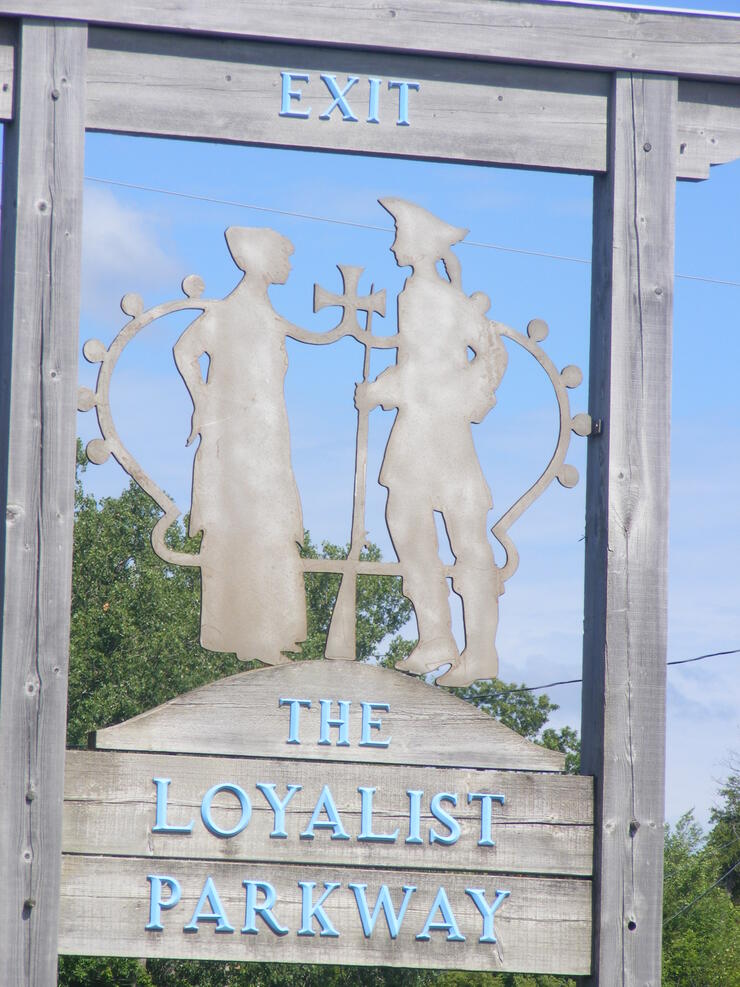
Recommended Articles

Bucket List Motorcycling in Ontario, Canada

Ontario's Best Twisties

The Big Belly Tour

It's Bike Night in Ontario 2024

Ontario's Top Twisties
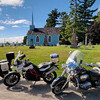
Here's Why Every Rider Needs to Hit Up Historic Highway 2

23 Amazing Photos That Prove PD13 Is Still The Best Motorcycle Event Ever
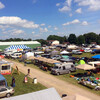
Motorcycle Swap Meets in Ontario—The Complete List for 2024

And a Vespa shall lead them all...







